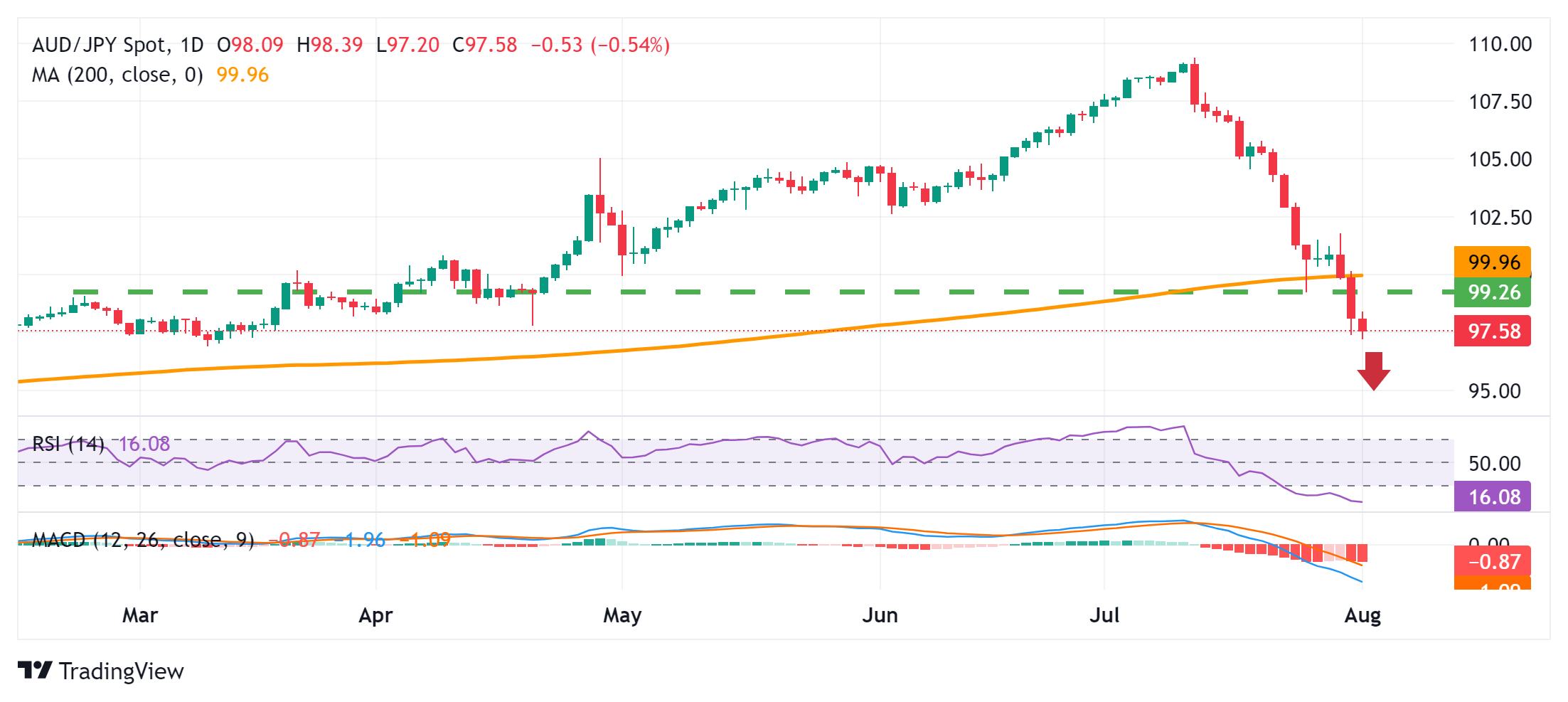- AUD/JPY retreats for a third consecutive day and dips to a new multi-month low.
- Post-BoJ JPY strength and China’s economic woes put pressure on spot prices.
- The oversold RSI warrants some caution for bears and positioning for further losses.
The AUD/JPY pair remains under some selling pressure for the third consecutive day on Thursday and drops to its lowest level since March 12, around the 97.20 region during the Asian session. However, spot prices manage to bounce back a few pips and are currently trading just above the 97.00 zone, although any meaningful recovery still seems elusive.
The Japanese Yen (JPY) continues to receive support from the Bank of Japan (BoJ)’s decision to raise the benchmark short-term interest rate on Wednesday by 15 basis points, the upper end of market expectations. Moreover, official data showed that Japanese authorities spent 5.53 trillion yen ($36.8 billion) intervening in the foreign exchange market in July, which is seen as another factor supporting the JPY and putting pressure on the AUD/JPY pair.
Meanwhile, a private survey showed business activity in China’s manufacturing sector unexpectedly contracted in July for the first time in nine months, underscoring economic woes. Moreover, Australian consumer inflation figures released on Wednesday dashed hopes for further rate hikes by the Reserve Bank of Australia (RBA) and weighed on the Australian Dollar (AUD), validating the negative outlook for the AUD/JPY pair.
From a technical perspective, the convincing overnight downside break through the all-important 200-day Simple Moving Average (SMA) and a subsequent drop below the 99.00 mark was seen as a fresh trigger for the bears. That said, the Relative Strength Index (RSI) shows extremely oversold conditions on the daily chart and warrants caution before positioning for further losses amid the risk-on sentiment, which tends to dampen demand for the JPY as a safe haven.
Any recovery attempt, however, now seems to face some resistance near the 77.75-77.80 region ahead of the 78.00 mark. Some follow-through buying could trigger a short-covering move and lift the AUD/JPY cross to the intermediate hurdle of 98.60 en route to the round figure of 99.00. The momentum could extend further, though it is likely to remain capped near the support breakpoint of the 200-day SMA, currently situated just below the psychological mark of 100.00.
On the other hand, the Asian session low, around the 97.20 area, could act as an immediate support ahead of the 97.00 round figure. A convincing break below the latter has the potential to drag the AUD/JPY cross to the next relevant support near the 96.65 region en route to the 96.00 mark and the yearly low, around the 95.00 zone, touched in February.
AUD/JPY daily chart
Bank of Japan FAQs
The Bank of Japan (BoJ) is the Japanese central bank, which sets the country’s monetary policy. Its mandate is to issue banknotes and carry out monetary and foreign exchange control to ensure price stability, which means an inflation target of around 2%.
The Bank of Japan has been pursuing ultra-loose monetary policy since 2013 in order to stimulate the economy and fuel inflation amid a low-inflation environment. The bank’s policy is based on Quantitative and Qualitative Easing (QQE), or printing money to buy assets such as government or corporate bonds to provide liquidity. In 2016, the bank doubled down on its strategy and further relaxed policy by first introducing negative interest rates and then directly controlling the yield on its 10-year government bonds.
The Bank of Japan’s massive stimulus has caused the Yen to depreciate against its major currency peers. This process has been exacerbated more recently by a growing policy divergence between the Bank of Japan and other major central banks, which have opted to sharply raise interest rates to combat decades-high inflation. The Bank of Japan’s policy of keeping rates low has led to a widening spread with other currencies, dragging down the value of the Yen.
The weak yen and the surge in global energy prices have caused Japanese inflation to rise, exceeding the Bank of Japan’s 2% target. However, the Bank of Japan judges that a sustainable and stable achievement of the 2% target is still not in sight, so a sharp change in current monetary policy seems unlikely.
Source: Fx Street
I am Joshua Winder, a senior-level journalist and editor at World Stock Market. I specialize in covering news related to the stock market and economic trends. With more than 8 years of experience in this field, I have become an expert in financial reporting.








